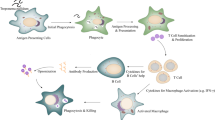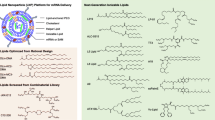Abstract
Human endogenous retrovirus W family (HERV-W) envelope (env) has been reported to be related to several human diseases, including autoimmune disorders, and it could activate innate immunity. However, there are no reports investigating whether human leukemia antigen (HLA)-A*0201+ restriction is involved in the immune response caused by HERV-W env in neuropsychiatric diseases. In the present study, HERV-W env-derived epitopes presented by HLA-A*0201 are described with the potential for use in adoptive immunotherapy. Five peptides displaying HLA-A*0201-binding motifs were predicted using SYFEPITHI and BIMAS, and synthesized. A CCK-8 assay showed peptides W, Q and T promoted lymphocyte proliferation. Stimulation of peripheral blood mononuclear cells from HLA-A*0201+ donors with each of these peptides induced peptide-specific CD8+ T cells. High numbers of IFN-γ-secreting T cells were also detectable after several weekly stimulations with W, Q and T. Besides lysis of HERV-W env-loaded target cells, specific apoptosis was also observed. These data demonstrate that human T cells can be sensitized toward HERV-W env peptides (W, Q and T) and, moreover, pose a high killing potential toward HERV-W env-expressing U251 cells. In conclusion, peptides W Q and T, which are HERV-W env antigenic epitopes, have both antigenicity and immunogenicity, and can cause strong T cell immune responses. Our data strengthen the view that HERV-W env should be considered as an autoantigen that can induce autoimmunity in neuropsychiatric diseases, such as multiple sclerosis and schizophrenia. These data might provide an experimental foundation for a HERV-W env peptide vaccine and new insight into the treatment of neuropsychiatric diseases.






Similar content being viewed by others
References
Assarsson E, Sidney J, Oseroff C, Pasquetto V, Bui HH, Frahm N, Brander C, Peters B, Grey H, Sette A. 2007. A quantitative analysis of the variables affecting the repertoire of T cell specificities recognized after vaccinia virus infection. J Immunol, 178: 7890–7901.
Belshaw R, Pereira V, Katzourakis A, Talbot G, Paces J, Burt A, Tristem M. 2004. Long-term reinfection of the human genome by endogenous retroviruses. Proc Natl Acad Sci U S A, 101: 4894–4899.
Blikstad V, Benachenhou F, Sperber GO, Blomberg J. 2008. Evolution of human endogenous retroviral sequences: a conceptual account. Cell Mol Life Sci, 65: 3348–3365.
Blond JL, Beseme F, Duret L, Bouton O, Bedin F, Perron H, Mandrand B, Mallet F. 1999. Molecular characterization and placental expression of HERV-W, a new human endogenous retrovirus family. J Virol, 73: 1175–1185.
Clausen J. 2003. Endogenous retroviruses and MS: using ERVs as disease markers. Int MS J, 10: 22–28.
Dantzer R, Konsman JP, Bluthe RM, Kelley KW. 2000. Neural and humoral pathways of communication from the immune system to the brain: parallel or convergent?. Auton Neurosci, 85: 60–65.
Dervillez X, Qureshi H, Chentoufi AA, Khan AA, Kritzer E, Yu DC, Diaz OR, Gottimukkala C, Kalantari M, Villacres MC et al., 2013. Asymptomatic HLA-A*02:01-restricted epitopes from herpes simplex virus glycoprotein B preferentially recall polyfunctional CD8+ T cells from seropositive asymptomatic individuals and protect HLA transgenic mice against ocular herpes. J Immunol, 191: 5124–5138.
Drexhage RC, Hoogenboezem TA, Cohen D, Versnel MA, Nolen WA, van Beveren NJ, Drexhage HA. 2011. An activated set point of T-cell and monocyte inflammatory networks in recentonset schizophrenia patients involves both pro- and anti-inflammatory forces. Int J Neuropsychopharmacol, 14: 746–755.
Duperray A, Barbe D, Raguenez G, Weksler BB, Romero IA, Couraud PO, et al. 2015. Inflammatory response of endothelial cells to a human endogenous retrovirus associated with multiple sclerosis is mediated by TLR4. Int Immunol, 27: 545–553.
Grandi N, Cadeddu M, Blomberg J, Tramontano E. 2016. Contribution of type W human endogenous retroviruses to the human genome: characterization of HERV-W proviral insertions and processed pseudogenes. Retrovirology, 13: 67.
Guo YJ, Wang KY, Sun SH. 2010. Identification of an HLAA* 0201-restricted CD8(+) T-cell epitope encoded within Leptospiral immunoglobulin-like protein A. Microbes Infect, 12: 364–373.
Hickel R, Meier C, Schiele R, Raab W, Petschelt A. 1991. Adverse side effects of amalgam? An interdisciplinary study. Dtsch Zahnarztl Z. 46, 542–544. (In German)
Huang WJ, Liu ZC, Wei W, Wang GH, Wu JG, Zhu F. 2006. Human endogenous retroviral pol RNA and protein detected and identified in the blood of individuals with schizophrenia. Schizophr Res, 83: 193–199.
Huang W, Li S, Hu Y, Yu H, Luo F, Zhang Q, Zhu F. 2011. Implication of the env gene of the human endogenous retrovirus W family in the expression of BDNF and DRD3 and development of recent-onset schizophrenia. Schizophr Bull, 37: 988–1000.
Imahashi N, Nishida T, Ito Y, Kawada J, Nakazawa Y, Toji S, Suzuki S, Terakura S, Kato T, Murata M, Naoe T. 2013. Identifica tion of a novel HLA-A*24:02-restricted adenovirus serotype 11-specific CD8+ T-cell epitope for adoptive immunotherapy. Mol Immunol, 56: 399–405.
Karlsson H, Bachmann S, Schroder J, McArthur J, Torrey EF, Yolken RH. 2001. Retroviral RNA identified in the cerebrospinal fluids and brains of individuals with schizophrenia. Proc Natl Acad Sci U S A, 98: 4634–4639.
Kessler JH, Mommaas B, Mutis T, Huijbers I, Vissers D, Benckhuijsen WE, Schreuder GM, Offringa R, Goulmy E, Melief CJ, van der Burg SH, Drijfhout JW. 2003. Competition-based cellular peptide binding assays for 13 prevalent HLA class I alleles using fluorescein-labeled synthetic peptides. Hum Immunol, 64: 245–255.
Li F, Karlsson H. 2016. Expression and regulation of human endogenous retrovirus W elements. APMIS, 124: 52–66.
Li S, Liu ZC, Yin SJ, Chen YT, Yu HL, Zeng J, Zhang Q, Zhu F. 2013. Human endogenous retrovirus W family envelope gene activates the small conductance Ca2+-activated K+ channel in human neuroblastoma cells through CREB. Neuroscience, 247: 164–174.
Liang B, Zhu L, Liang Z, Weng X, Lu X, Zhang C, Li H, Wu X. 2006. A simplified PCR-SSP method for HLA-A2 subtype in a population of Wuhan, China. Cell Mol Immunol, 3: 453–458.
Mullins CS, Linnebacher M. 2012. Endogenous retrovirus sequences as a novel class of tumor-specific antigens: an example of HERV-H env encoding strong CTL epitopes. Cancer Immunol Immunother, 61: 1093–1100.
Mameli G, Poddighe L, Astone V, Delogu G, Arru G, Sotgiu S, et al. 2009. Novel reliable real-time PCR for differential detection of MSRVenv and syncytin-1 in RNA and DNA from patients with multiple sclerosis. J Virol Methods, 161: 98–106.
Paul S, Weiskopf D, Angelo MA, Sidney J, Peters B, Sette A. 2013. HLA class I alleles are associated with peptide-binding repertoires of different size, affinity, and immunogenicity. J Immunol, 191: 5831–5839.
Perron H, Dougier-Reynaud HL, Lomparski C, Popa I, Firouzi R, Bertrand JB, Marusic S, Portoukalian J, Jouvin-Marche E, Villiers CL, Touraine JL, Marche PN. 2013. Human endogenous retrovirus protein activates innate immunity and promotes experimental allergic encephalomyelitis in mice. PLoS One, 8: e80128.
Perron H, Germi R, Bernard C, Garcia-Montojo M, Deluen C, Farinelli L, et al. 2012. Human endogenous retrovirus type W envelope expression in blood and brain cells provides new insights into multiple sclerosis disease. Mult Scler, 18: 1721–1736.
Perron H, Lang A. 2010. The human endogenous retrovirus link between genes and environment in multiple sclerosis and in multifactorial diseases associating neuroinflammation. Clin Rev Allergy Immunol, 39: 51–61.
Perron H, Jouvin-Marche E, Michel M, Ounanian-Paraz A, Camelo S, Dumon A, et al. 2001. Multiple sclerosis retrovirus particles and recombinant envelope trigger an abnormal immune response in vitro, by inducing polyclonal Vbeta16 T-lymphocyte activation. Virology, 287: 321–332.
Perron H, Geny C, Laurent A, Mouriquand C, Pellat J, Perret J, et al. 1989. Leptomeningeal cell line from multiple sclerosis with reverse transcriptase activity and viral particles. Res Virol, 140: 551–561.
Qin C, Li S, Yan Q, Wang X, Chen Y, Zhou P, Lu M, Zhu F. 2016. Elevation of Ser9 phosphorylation of GSK3β is required for HERV-W env-mediated BDNF signaling in human U251 cells. Neurosci Lett, 627: 84–91.
Rolland A, Jouvin-Marche E, Viret C, Faure M, Perron H, Marche PN. 2006. The envelope protein of a human endogenous retrovirus- W family activates innate immunity through CD14/TLR4 and promotes Th1-like responses. J Immunol, 176: 7636–7644.
Romanish MT, Cohen CJ, Mager DL. 2010. Potential mechanisms of endogenous retroviral-mediated genomic instability in human cancer. Semin Cancer Biol, 20: 246–253.
Sotgiu S, Mameli G, Serra C, Zarbo IR, Arru G, Dolei A. 2010. Multiple sclerosis-associated retrovirus and progressive disability of multiple sclerosis. Mult Scler, 16: 1248–1251.
Seyed N, Zahedifard F, Safaiyan S, Gholami E, Doustdari F, Azadmanesh K, Mirzaei M, Saeedi Eslami N, Khadem Sadegh A, Eslami Far A, Sharifi I, Rafati S. 2011. In silico analysis of six known Leishmania major antigens and in vitro evaluation of specific epitopes eliciting HLA-A2 restricted CD8 T cell response. PLoS Negl Trop Dis, 5: e1295.
Tang B, Zhou W, Du J, He Y, Li Y. 2015. Identification of human leukemia antigen A*0201-restricted epitopes derived from epidermal growth factor pathway substrate number 8. Mol Med Rep, 12: 1741–1752.
van Horssen J, van der Pol S, Nijland P, Amor S, Perron H. 2016. Human endogenous retrovirus W in brain lesions: Rationale for targeted therapy in multiple sclerosis. Mult Scler Relat Disord, 8: 11–18.
Wang X, Wang BR, Zhang XJ, Xu Z, Ding YQ, Ju G. 2002. Evidences for vagus nerve in maintenance of immune balance and transmission of immune information from gut to brain in STMinfected rats. World J Gastroenterol, 8: 540–545.
Yu H, Liu T, Zhao Z, Chen Y, Zeng J, Liu S, Zhu F. 2014. Mutations in 3′-long terminal repeat of HERV-W family in chromosome 7 upregulate syncytin-1 expression in urothelial cell carcinoma of the bladder through interacting with c-Myb. Oncogene, 33: 3947–3958.
Acknowledgments
This work was supported by grants from the National Natural Sciences Foundation of China (no. 31470264, no. 81271820, no. 30870789 and no. 30300117), the Key Program of the Natural Science Foundation of Hubei Province of China (no. 2014CFA078), the Stanley Foundation from the Stanley Medical Research Institute (SMRI), USA (no. 06R-1366), for Dr. F Zhu, and the Scientific Innovation Team Project of Hubei Province of China (no. 2015CFA009).
Author information
Authors and Affiliations
Contributions
FZ designed the experiments. XNT, SL and RX carried out the experiments. LJZ provided the blood samples. XLW analyzed the date. XNT prepared the figures and/or tables and drafted the manuscript. FZ finalized the manuscript. All authors read and approved the final manuscript.
Corresponding author
Ethics declarations
The authors declare that they have no conflict of interest.
The study was approved by the Ethics Committee of Wuhan University School of Medicine.
Rights and permissions
About this article
Cite this article
Tu, X., Li, S., Zhao, L. et al. Human leukemia antigen-A*0201-restricted epitopes of human endogenous retrovirus W family envelope (HERV-W env) induce strong cytotoxic T lymphocyte responses. Virol. Sin. 32, 280–289 (2017). https://doi.org/10.1007/s12250-017-3984-9
Received:
Accepted:
Published:
Issue Date:
DOI: https://doi.org/10.1007/s12250-017-3984-9




